Regional selective neuronal degeneration after protein phosphatase inhibition in hippocampal slice cultures: evidence for a MAP kinase-dependent mechanism
- PMID: 9736650
- PMCID: PMC6793243
- DOI: 10.1523/JNEUROSCI.18-18-07296.1998
Regional selective neuronal degeneration after protein phosphatase inhibition in hippocampal slice cultures: evidence for a MAP kinase-dependent mechanism
Abstract
The regional selectivity and mechanisms underlying the toxicity of the serine/threonine protein phosphatase inhibitor okadaic acid (OA) were investigated in hippocampal slice cultures. Image analysis of propidium iodide-labeled cultures revealed that okadaic acid caused a dose- and time-dependent injury to hippocampal neurons. Pyramidal cells in the CA3 region and granule cells in the dentate gyrus were much more sensitive to okadaic acid than the pyramidal cells in the CA1 region. Electron microscopy revealed ultrastructural changes in the pyramidal cells that were not consistent with an apoptotic process. Treatment with okadaic acid led to a rapid and sustained tyrosine phosphorylation of the mitogen-activated protein kinases ERK1 and ERK2 (p44/42(mapk)). The phosphorylation was markedly reduced after treatment of the cultures with the microbial alkaloid K-252a (a nonselective protein kinase inhibitor) or the MAP kinase kinase (MEK1/2) inhibitor PD98059. K-252a and PD98059 also ameliorated the okadaic acid-induced cell death. Inhibitors of protein kinase C, Ca2+/calmodulin-dependent protein kinase II, or tyrosine kinase were ineffective. These results indicate that sustained activation of the MAP kinase pathway, as seen after e.g., ischemia, may selectively harm specific subsets of neurons. The susceptibility to MAP kinase activation of the CA3 pyramidal cells and dentate granule cells may provide insight into the observed relationship between cerebral ischemia and dementia in Alzheimer's disease.
Figures
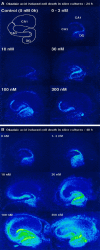

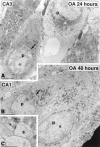
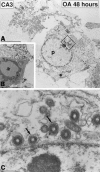
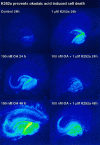
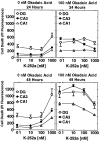

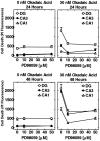
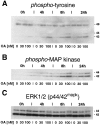
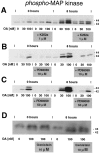
Similar articles
-
Apoptosis induced in neuronal cultures by either the phosphatase inhibitor okadaic acid or the kinase inhibitor staurosporine is attenuated by isoquinolinesulfonamides H-7, H-8, and H-9.J Mol Neurosci. 1996 Spring;7(1):65-76. doi: 10.1007/BF02736849. J Mol Neurosci. 1996. PMID: 8835783
-
CGP 41251 and tamoxifen selectively inhibit mitogen-activated protein kinase activation and c-Fos phosphoprotein induction by substance P in human astrocytoma cells.Cell Growth Differ. 1997 Nov;8(11):1225-40. Cell Growth Differ. 1997. PMID: 9372245
-
Ca(2+)-permeable AMPA receptors induce phosphorylation of cAMP response element-binding protein through a phosphatidylinositol 3-kinase-dependent stimulation of the mitogen-activated protein kinase signaling cascade in neurons.J Neurosci. 1999 Jul 15;19(14):5861-74. doi: 10.1523/JNEUROSCI.19-14-05861.1999. J Neurosci. 1999. PMID: 10407026 Free PMC article.
-
Mechanisms of mitogenic and anti-apoptotic signaling by glucose-dependent insulinotropic polypeptide in beta(INS-1)-cells.J Endocrinol. 2002 Aug;174(2):233-46. doi: 10.1677/joe.0.1740233. J Endocrinol. 2002. PMID: 12176662
-
Gi-mediated activation of mitogen-activated protein kinase (MAPK) pathway by receptor mimetic basic secretagogues of connective tissue-type mast cells: bifurcation of arachidonic acid-induced release upstream of MAPK.J Pharmacol Exp Ther. 1999 Jun;289(3):1654-61. J Pharmacol Exp Ther. 1999. PMID: 10336565
Cited by
-
Insulin-like growth factor 1 inhibits extracellular signal-regulated kinase to promote neuronal survival via the phosphatidylinositol 3-kinase/protein kinase A/c-Raf pathway.J Neurosci. 2005 Mar 16;25(11):2838-52. doi: 10.1523/JNEUROSCI.5060-04.2005. J Neurosci. 2005. PMID: 15772344 Free PMC article.
-
Coactivation of beta-adrenergic and cholinergic receptors enhances the induction of long-term potentiation and synergistically activates mitogen-activated protein kinase in the hippocampal CA1 region.J Neurosci. 2000 Aug 15;20(16):5924-31. doi: 10.1523/JNEUROSCI.20-16-05924.2000. J Neurosci. 2000. PMID: 10934239 Free PMC article.
-
Sustained extracellular signal-regulated kinase activation by 6-hydroxydopamine: implications for Parkinson's disease.J Neurochem. 2001 May;77(4):1058-66. doi: 10.1046/j.1471-4159.2001.00304.x. J Neurochem. 2001. PMID: 11359871 Free PMC article.
-
Chronic CXCL10 alters the level of activated ERK1/2 and transcriptional factors CREB and NF-kappaB in hippocampal neuronal cell culture.J Neuroimmunol. 2008 Mar;195(1-2):36-46. doi: 10.1016/j.jneuroim.2008.01.003. Epub 2008 Mar 10. J Neuroimmunol. 2008. PMID: 18329727 Free PMC article.
-
Translocation of ethanolamine phosphoglyceride is required for initiation of apoptotic death in OLN-93 oligodendroglial cells.Neurochem Res. 2005 Oct;30(10):1257-67. doi: 10.1007/s11064-005-8797-9. Neurochem Res. 2005. PMID: 16341587
References
-
- Alessi DR, Cuenda A, Cohen P, Dudley DT, Saltiel AR. PD 098059 is a specific inhibitor of the activation of mitogen-activated protein kinase kinase in vitro and in vivo. J Biol Chem. 1995;270:27489–27494. - PubMed
-
- Ankarcrona M, Dypbukt JM, Orrenius S, Nicotera P. Calcineurin and mitochondrial function in glutamate-induced neuronal cell death. FEBS Lett. 1996;394:321–324. - PubMed
-
- Arendt T, Holzer M, Grossmann A, Zedlick D, Bruckner MK. Increased expression and subcellular translocation of the mitogen-activated protein kinase kinase and mitogen-activated protein kinase in Alzheimer’s disease. Neuroscience. 1995;68:5–18. - PubMed
-
- Benito A, Lerga A, Silva M, Leon J, Fernandez-Luna JL. Apoptosis of human myeloid leukemia cells induced by an inhibitor of protein phosphatases (okadaic acid) is prevented by Bcl-2 and Bcl-XL. Leukemia. 1997;11:940–944. - PubMed
Publication types
MeSH terms
Substances
LinkOut - more resources
Full Text Sources
Other Literature Sources
Miscellaneous
